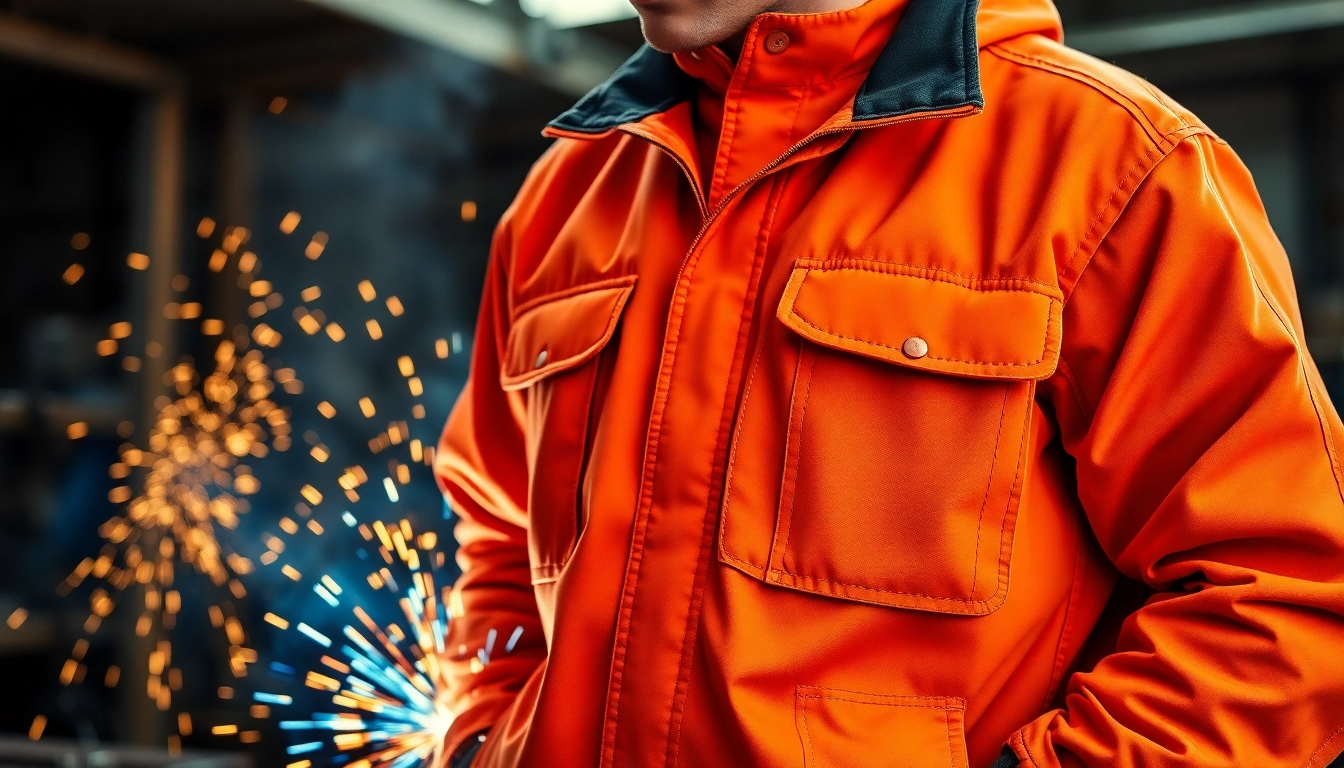Understanding Welding Jackets
Working in the welding industry presents unique challenges where personal safety is a top priority. One essential piece of protective equipment is the welding jacket. These jackets play a crucial role in safeguarding welders from dangerous elements, including heat, sparks, and molten metal. This article explores various facets of welding jackets, guiding you in selecting the right one to enhance safety during your welding tasks.
Types of Welding Jackets Available
Welding jackets come in various styles and materials to cater to different welding applications and personal preferences. Here are some commonly found types:
- Cotton Welding Jackets: Often made from flame-resistant cotton, these jackets are lightweight and comfortable, making them suitable for light to moderate welding tasks.
- Leather Welding Jackets: Known for their durability and excellent protection, leather jackets are crafted from cowhide or other animal hides, making them ideal for heavy-duty welding and harsher environments.
- Hybrid Jackets: Combining materials like cotton and leather or synthetic fibers, hybrid jackets provide the benefits of both types, offering a balance between protection and comfort.
- Hi-Visibility Jackets: These are designed for use in low-light conditions, featuring bright colors and reflective strips to enhance visibility on job sites.
Importance of Flame Resistance in Welding Jackets
The risk of fire and burns is a significant concern for welders, making flame resistance a critical feature of any welding jacket. Flame-resistant materials are specifically designed to self-extinguish when they come into contact with flames or intense heat, protecting the wearer from severe injuries. These materials undergo tests to meet strict safety standards, ensuring their effectiveness. Opting for jackets with proper flame resistance can prevent injuries and enhance your safety on the job.
Key Features to Look for in a Welding Jacket
When selecting a welding jacket, it’s essential to consider various features that enhance safety and comfort:
- Fit: A good fit ensures that the jacket doesn’t restrict movement while still covering vulnerable areas adequately.
- Material: As discussed previously, choose between cotton, leather, or hybrid options based on the welding conditions you’ll face.
- Pockets: Look for jackets with pockets for tools and personal items. This feature enhances convenience while working.
- Length: Longer jackets provide more coverage, protecting the lower body from sparks and other potential hazards.
- Breathability: Opt for jackets with breathable materials or vents to ensure comfort during prolonged use, especially in warm environments.
Selecting the Best Material for Your Welding Jacket
Choosing the right material for your welding jacket is paramount in ensuring both safety and comfort. The material impacts how well the jacket can protect you while also affecting breathability and ease of movement.
Leather vs. Cotton: Which is Better?
Leather and cotton are the two most common materials used in welding jackets, each with its benefits:
- Leather: Offers superior protection against heat, sparks, and spatter. Ideal for heavy-duty welding, leather is durable but may be heavy and less breathable.
- Cotton: Lightweight and breathable, making it suitable for lighter applications and cooler environments. Look for flame-resistant treated cotton options for added protection, though they may not offer the same level of durability as leather.
Your choice should depend on the nature of your welding tasks and the environmental conditions you work in.
Benefits of Hybrid Welding Jackets
Hybrid jackets are becoming increasingly popular due to their versatility. By combining materials such as flame-resistant cotton and leather, these jackets provide the best of both worlds. They often feature reinforced areas to withstand sparks while maintaining comfort through lightweight and breathable zones. For welders who work in various conditions, hybrid options can be a great compromise, ensuring maximum safety without sacrificing mobility.
Impact of Weather Conditions on Jacket Choice
The weather can significantly influence your choice of a welding jacket. For cold or wet conditions, a heavier leather jacket may be preferred for insulation and protection against elements. Conversely, in warmer climates, lightweight, breathable cotton jackets can prevent overheating, allowing for increased airflow. Consideration of climate conditions enables welders to choose jackets that not only protect but also enhance comfort throughout their workday.
Buying Guide: What to Consider When Choosing a Welding Jacket
Choosing the right welding jacket involves more than just selecting a style. Here are some essential factors that you should keep in mind:
Size and Fit Considerations
Fit is imperative when choosing a welding jacket. A properly fitted jacket should cover your arms and torso without being too loose or too tight. Overly loose jackets can catch on equipment, while tighter fits may restrict movement. Always refer to the manufacturer’s sizing chart before purchase to ensure you select an appropriate size.
Price Range and Budgeting for Welders
Welding jackets come in a broad spectrum of prices, influenced by brand, material, and safety features. Basic cotton models can start as low as $20, while high-end leather jackets might reach $300 or more. It’s crucial to balance budget and quality, ensuring the jacket provides adequate protection without exceeding your financial limits. Consider the jacket your first line of defense and invest accordingly.
Brand Recommendations and Reviews
When purchasing a welding jacket, consider brands that are known for their quality and reliability in the welding industry. Brands like Miller, Revco, and Black Stallion have established reputations for producing safety gear that welders trust. Prioritize selecting jackets that have positive reviews and feedback regarding their comfort, durability, and flame resistance.
Maintaining Your Welding Jacket for Longevity
To maximize the lifespan of your welding jacket and maintain its safety features, appropriate care and maintenance are crucial. Here are recommended practices:
Cleaning and Care Tips for Flame-Resistant Fabrics
Proper cleaning not only maintains the appearance of your jacket but also ensures its flame-retardant properties are intact. Always follow the care instructions provided by the manufacturer. Common cleaning practices include:
- Machine wash on a gentle cycle with cold water for cotton jackets.
- For leather jackets, use a damp cloth to wipe down and avoid submerging them in water.
- Air dry your jackets, as heat can degrade the flame-resistant properties.
Repairing Common Wear and Tear
Routine inspections for wear and tear are vital. Check for frayed seams, burnt areas, or damaged snaps and zippers. Minor repairs like sewing small holes can extend the life of your jacket. If the damage is beyond repair, it may be time to consider a replacement.
When to Replace Your Welding Jacket
Even with proper care, welding jackets have a finite life. Replace your jacket when you notice significant wear and tear or when flame resistance is compromised. A good rule of thumb is to inspect your jackets regularly and look for visible evidence of degradation. Failure to do so could result in inadequate protection while welding.
Expert Tips for Enhanced Safety While Welding
While a quality welding jacket is vital, it shouldn’t be the only piece of safety equipment you rely on. Here are some tips for enhancing safety while welding:
Complementing Your Welding Jacket with Other Gear
Always complement your welding jacket with other personal protective equipment (PPE). Essential gear includes:
- Welding helmets with proper shade lenses to protect your eyes from UV radiation and sparks.
- Leather gloves to protect your hands from heat and abrasions.
- Steel-toed boots to shield your feet from heavy falling objects.
Common Welding Hazards and Precautions
Be aware of common welding hazards, such as fire, electric shock, and eye damage. To mitigate these risks:
- Always check your workspace for flammable materials before welding.
- Use appropriate ventilation to prevent the buildup of harmful fumes.
- Have a fire extinguisher readily available at your worksite.
Staying Comfortable During Long Welding Sessions
Welding can require prolonged periods of standing and moving, leading to fatigue. To maintain comfort:
- Take regular breaks to stretch and hydrate.
- Choose a jacket with ventilation features designed to wick moisture away from your skin.
- Wear moisture-wicking undergarments to stay dry and comfortable throughout your work session.
The welding jacket is more than just a piece of clothing; it’s an essential aspect of a welder’s safety gear. By understanding the different types of jackets available, their materials, maintenance strategies, and the importance of proper fit, users can significantly enhance their personal safety. For those looking for quality options, consider exploring brands such as those available at welding jacket category. Investing in the right protection can lead to safer, more comfortable, and effective welding experiences.


